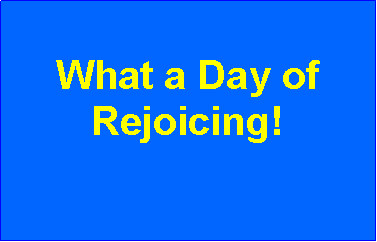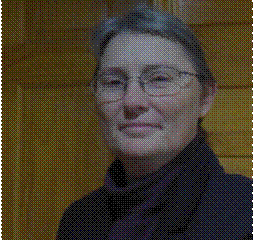
|
By Connie Adkerson Student, Church of God Bible Institute |
|
I sat down, coffee in hand, to read and consider my morning devotion. The text was John 7:37, “In the last day, that great day of the feast, Jesus stood and cried saying, If any man thirst let him come to me and drink!” The words “the last day, that great day of the feast” jumped out at me. What did they mean? What was the last great day? What feast? My morning reading did not answer the questions. Knowing God does not put anything in the Bible without purpose, I decided to find out.
Jesus, a devout Jew, was in Jerusalem celebrating the Feast of Tabernacles, known to the Jews as “Sukkot.” The Hebrew word sukkot means booths or temporary shelters that the Jewish people constructed and lived in for 7 days during the time of the feast. The word is frequently translated into English as “tabernacle,” but the tabernacle in the Bible refers to the portable sanctuary in the desert and was the precursor to the Temple which was built in Jerusalem.
While wandering in the wilderness, the Hebrews received instructions for the feast from God through Moses. According to Exodus 23:14-17 and Deuteronomy 16:16-17, the Feast of Tabernacles is one of three feasts mentioned (Unleavened Bread, Weeks, Tabernacles) which requires all Jewish males to gather before the Lord and give offerings.
After entering the Promised Land and making Jerusalem the capital, all Jewish males made a pilgrimage to that city as required. Instructions for the Sukkot are found throughout several books of the Bible (Leviticus 23:29-43, Deuteronomy 16:16-17, Exodus 23:14-17 and Numbers 29:12-35). Its purpose was twofold: First, to give thanksgiving for the final yearly harvest of the growing season. It is a harvest festival and is also known as the Festival of In-Gathering. Secondly, to remember God's deliverance from Egypt and provision while the Hebrews wandered in the wilderness before they entered the Promised Land and how they lived in temporary shelters and God resided with them, providing all they needed.
Sukkot was the fourth feast of the Jewish year and the last of the fall feasts. Based upon the moon cycle, it was held sometime in September or October which corresponded with harvest. All grain and fruit of the land had been harvested, the people gave thanks and it was a time of rejoicing for the entire community, both Jew and Gentile.
Many scholars believe Jesus was born during the time of the Feast of Sukkot. John 1:14 says, “The Word became flesh and dwelt [Greek: tabernacled] among us . . . .” God tabernacled with us in person and He continues to tabernacle with us in our temporal bodies through His Holy Spirit. Surely this is the “tidings of great joy” the angels declared in Luke 2:10-11.
Traditionally in celebration of the festival along with other instructions in the Scriptures, the Jews would light candles at the start of the feast. Oral tradition tells us that in Jesus' day there were two huge (75-foot tall) menorahs located in the Court of Women in the Temple. These lamps were filled with oil and left burning during the festival as a representation of the time when God's Shekinah glory filled the temple. Jerusalem and the temple sat on a hill and the light from the burning lamps could be seen glowing from the temple mount.
It was during or just following the Feast of Sukkot that Jesus stood at the temple and announced that He is the light of the world (John 8:12). The people listening to Him would have understood He was saying He is the Shekinah Glory or light of God Himself. In Acts 13:47 Paul tells us the light has been brought to the Gentiles and salvation is available to all. God's glory should fill our lives for all the world to see. Jesus said in Matthew 5:14, “Ye are the light of the world. A city that is set on a hill cannot be hid.”
The seventh day of the feast is known as “The Great Day,” and on that day the priest would collect water from the Pool of Siloam and pour both water and wine out at the altar. As the priest poured out the water the people would recite Psalms 118:25-26, which says in part, “Save now, I beseech thee, O Lord . . . .” Water is vital to life and is a scarce, precious resource in the Middle Eastern deserts.
It was on the great day Jesus pro-claimed in John 7:27-38, “. . . if any man thirst, let him come unto me and drink. He that believeth on me as the scripture hath said, out of his belly shall flow rivers of living water.” John goes on to tell us Jesus was speaking of the Holy Spirit as the water that we receive as believers. The Holy Spirit is a vital, precious resource for our spiritual life and it is scarce in the thirsty world around us.
Understanding this tradition helps us understand the reaction of the people listening to Jesus. Many believed He was a prophet, some believed He was the Christ and some desired to lay hands upon Him in anger. People continue to have the same reaction to Jesus today. The Holy Spirit was poured out the first time on the believers in the Upper Room as recorded in Acts 2 and as foretold by the prophet in Zechariah 13:1: A fountain of living water began to flow out of Jerusalem through the believers as the Gospel was spread to all parts of the parched earth.
A short devotion on a cold December morning became several hours of study, prayers, and rejoicing. My study revealed a rich tapestry of ceremony, traditions and celebrations illuminating Jesus. The Feast of Sukkot given to Moses points to a time when Jesus would come into the world to tabernacle with mankind and then send His Holy Spirit to tabernacle with all believers in our temporal, mortal bodies. For the Hebrews the purpose of the feast was twofold: to remember God's deliverance from Egypt and His provisions; and second to give thanks for the yearly harvest.
For believers the purpose of the feast is also two fold. The first is to remember our deliverance from the bondage of sin in the world and His provisions in the wilderness of life. The second is thanksgiving for the harvest of believers into the church. Jesus' resurrection is the first fruits (1 Corinthians 15:23), and the church was firmly established in the spring at Pentecost. The church is now planting and harvesting as Jesus said in John 4:37-38, “. . . One soweth and another reapeth.” Someday the final soul will be reaped by the church. All believers, Jew and Gentile, will pilgrimage to our heavenly home to gather before the Lord. We will celebrate a grand Sukkot with Jesus, looking back at our time in bondage in spiritual Egypt, His provision for our life in the wilderness, and joyfully give thanks to Him for the harvest of our souls.
References Holman Illustrated Bible Dictionary, (2003) Holman Bible Publishers, Nashville, TN Life Application Bible (NLT), (1996) Tyndale Publishers, Wheaton, Illinois The King James Bible www.Bibletruth.org/feastoftabernacles www.cbn.com/biblestudy/findingjesusinthefeastoftabernacles www.feast.icej.org/about www.gotquestions.org/feastoftabernacles www.Judaism101.org
Vincent’s Word Studies on John 7:37
The last day . . . the close of the whole festival, and kept as a Sabbath (Lev. 23:36). It was called the Day of the Great Hosanna, because a circuit was made seven times round the altar with “hosanna;” also the Day of Willows, and the Day of Beating the Branches, because all the leaves were shaken off the willow-boughs, and the palm branches beaten in pieces by the side of the altar. Every morning, after the sacrifice, the people, led by a priest, repaired to the Fountain of Siloam, where the priest filled a golden pitcher, and brought it back to the temple amid music and joyful shouts. Advancing to the altar of burnt offering, at the cry of the people, “Lift up thy hand!” he emptied the pitcher toward the west, and toward the east a cup of wine, while the people chanted, “With joy shall ye draw water out of the wells of salvation.” . . .
There can be no doubt that the following words of the Lord had reference to that ceremony.
|
